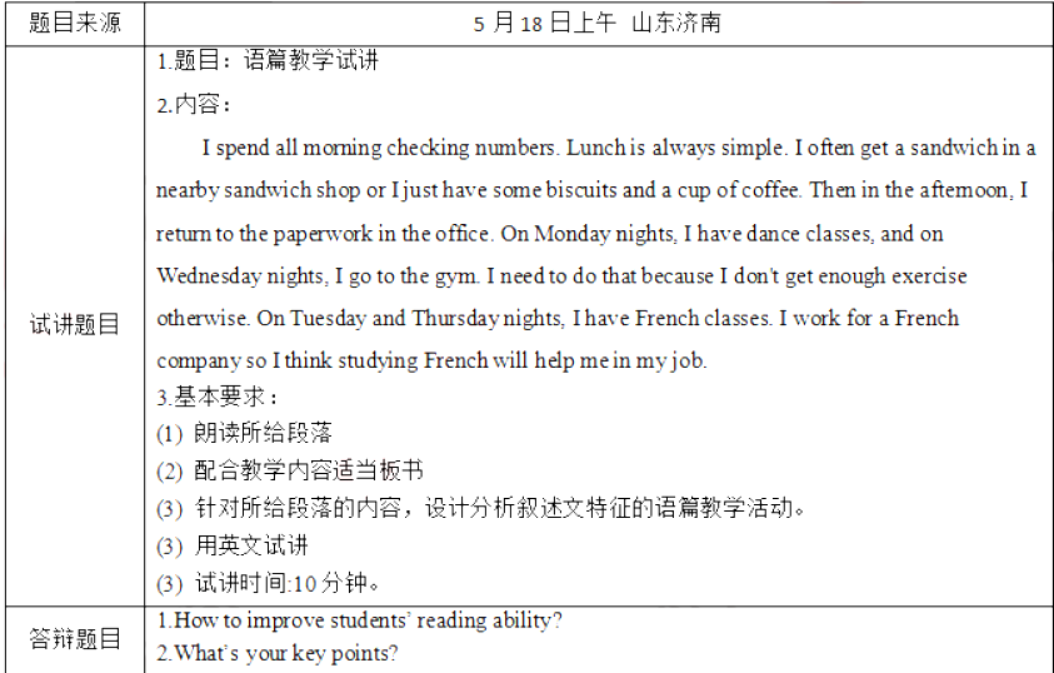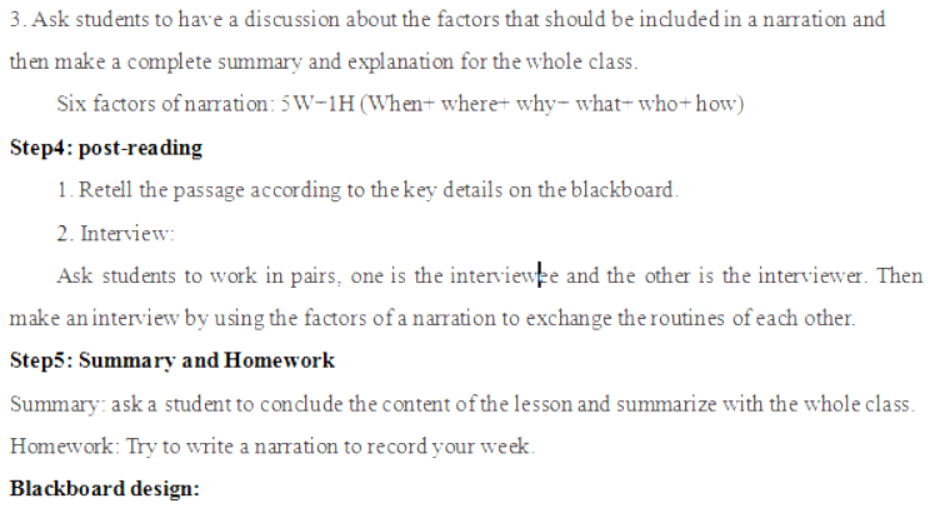英语阅读和汉语阅读不一样,它不会涉及语音解码。
题目
英语阅读和汉语阅读不一样,它不会涉及语音解码。
相似考题
更多“英语阅读和汉语阅读不一样,它不会涉及语音解码。”相关问题
-
第1题:
洋泾浜英语的基本特征是()A.语音、词汇是英语的,语法基本上是汉语的
B.词汇主要是英语的,语音、语法基本上是汉语的
C.语音有较大改动,词汇、语法基本上是英语的
D.语音有较大改动,词汇主要是英语的,语法基本上是汉语的答案:D解析: -
第2题:
小学英语阅读
一、考题回顾
 答案:解析:二、考题解析
答案:解析:二、考题解析
【教案】
Teaching aims:
Knowledge aim: Students will understand the story and know the meaning of “pull...out of” and “be stuck in”.
Ability aim: Students can be able to collect the main idea and the details.
Emotional aim: Students will develop the interest in learning English.
Teaching key and difficult points:
Key point: Students will know the meaning of “pull...out of” and “be stuck in”.
Students can be able to collect the main idea and the details.
Difficult point: Students will develop the interest in learning English.
Teaching Aids:
Teaching procedures:
Step 1: Warming-up
1. Greeting: Ask “how are you today?”.
2. Sing a song named Little Ant for students
The ants go marching one by one, hurrah,hurrah!
The ants go marching two by two, hurrah,hurrah!
The ants go marching three by three.
The little one stops to climb a tree.
And they all go marching down to the ground
To get out of the rain,
BOOM! BOOM! BOOM!
Ask them “are you happy now?” and “ do you find some ants in this song?”. Then tell them we will learn a small interesting story about the ant.
Step 2: Pre-reading
1. Briefly explain the meaning of “pull...out of” and “ be stuck in” with pictures.
Step 3: While-reading
1. Ask students to read the short story for the first time. After that, ask them to tell me what the main idea of the story is.
2. Ask students to read it for the second time. This time, students need to find what the weather is like today and the next day.
3. Let them read it for the third time, and answer the questions: how they feel and what’s wrong with them?
Step 4: Post-reading
Ask students to work in a group of four, and try to retell the short story in their own words according to the clues on the black board.
Step 5: Summary and homework
Summary: Conclude the content of the lesson and summarize with whole class.
Homework: Think about what will happen to them in the third day, share with us next lesson.
Blackboard design:

【答辩题目解析】
1.Do you think it is important to teach students the phenomenon or not?
【参考答案】
I think it is very important. There are several reasons as following. First, some knowledge is too abstract or general to understand. Teaching the phenomenon to students can help them quickly understand what they are learning. Second, after doing that, students can remember the knowledge according to the logic or other aspects, which is conducive to consolidating and memorizing the knowledge they have learned as solid as possible.
【答辩题目解析】
2.How to improve students speaking ability?
【参考答案】
First, the teacher should create a relaxing learning atmosphere and stimulate students’ learning interest. Introducing activities, such as games and competitions that students like into the classroom can fully mobilize the enthusiasm of students, and turn "speaking English" into a pleasant experience. Second, the teacher also needs to create the real situation. Their interest can be inspired in the process of using in the situation. Third, the teacher needs to strengthen oral training with various forms, such as role-play, telling a story. -
第3题:
英语阅读课的主要教学目标是()。
A语音教学
B词汇教学
C口头和书面表达能力的训练
D阅读理解能力的培养和基本的阅读策略的训练
D
略 -
第4题:
下列关于共家学派的知识结构说法错误的是()
- A、它包括对中外哲学经典的阅读
- B、它包括对马恩原典著作的阅读
- C、它不要求掌握古代汉语知识
- D、它要求对格律诗、书法的掌握
正确答案:C -
第5题:
国际音标只能记录英语和汉语普通话等的语音,不能记录汉语方言的语音。
正确答案:错误 -
第6题:
汉语的阅读主要依靠()。
- A、视觉
- B、听觉
- C、语音
- D、触觉
正确答案:A -
第7题:
在下列选项中,除了(),其余都属于阅读的学习策略。
- A、培养学生和讲英语国家的人直接交流的能力
- B、选择阅读材料
- C、利用阅读技巧
- D、提高阅读速度和扩大阅读量
正确答案:A -
第8题:
读音和规则是汉语阅读的主要注重点。
正确答案:错误 -
第9题:
单选题信息技术整合于英语阅读教学的优势不包括()A提供广泛的英语阅读学习资源
B提供支持学生进行阅读实践活动的工具
C交流方式单一
D提供各种学习策略
正确答案: B解析: 暂无解析 -
第10题:
单选题在下列选项中,除了(),其余都属于阅读的学习策略。A培养学生和讲英语国家的人直接交流的能力
B选择阅读材料
C利用阅读技巧
D提高阅读速度和扩大阅读量
正确答案: C解析: 暂无解析 -
第11题:
判断题国际音标只能记录英语和汉语普通话等的语音,不能记录汉语方言的语音。A对
B错
正确答案: 对解析: 国际音标能够记录世界上所有语言及其方言的语音。 -
第12题:
判断题新标准指出,汉语拼音的功能是帮助阅读,学习语音时,能够直呼音节。A对
B错
正确答案: 对解析: 暂无解析 -
第13题:
高中英语 阅读
一、考题回顾
 答案:解析:二、考题解析
答案:解析:二、考题解析
【教案】
Teaching aims:
Knowledge aims:
(1) Students are able to understand the content of the passage.
(2) Students can know some basic information of narration.
Ability aim:
Students can use different basic reading strategies like analyzing, grasping details correctly in their reading process.
After this lesson, students can write a narration by themselves.
Emotional aim:
Students will be more willing to get involved in class activities and boost their interest in learning English.
Key and difficult point:
Key Point: understand the characteristics of narration.
Difficult Point: improve students’ learning interest and write a narration by themselves.
Teaching procedures:
Step 1: Warming-up
1. Greeting.
2. Have a free talk:
Ask students some questions about their weekend. For example,
1). Did you enjoy your weekend?
2). What did you do on your last weekend? And how about your week days, what did you do?
3.Then ask students to answer the questions and give them some feedback. Then tell them I have friend John he had wrote a short passage to describe his week, and ask my students if they want to know his week or not to lead in the topic of today: “My week”.
Step 2: Pre-reading
1.Prediction.
Ask students to make a prediction about what John does during his week and invite some students to share their ideas.
Write down some of their answers on the blackboard to recall some related words and give evaluation to the students.
Step 3: While-reading
A. Extensive reading
1.Let students to read the passage for the first time. Ask students a question: What does the passage talk about? (This passage talks about the week of the writer)
2.Then invite one student answer the question and give evaluation.
B. Intensive reading
1.Ask students to read the passage for the second time and finish the exercise on the blackboard:
1). John’s lunch is diversified. (T/F)
2). When does John return to the paperwork in the office?
3). What does John do on Monday nights?
4). Where does John go on Wednesday nights?
5). Why does the author study French?
…
2.Then invite two students to answer these questions separately and give evaluation. Write down the right answers on the blackboard.



Reading ability plays a very important role in the process of learning. It is an important part of students’ overall ability. If we want to communicate with others, we should understand what someone is saying. So as a teacher, we should try our best to help students improve their listening ability.
First, before reading, we should lead the students to get familiar with the topic and the potential new words, so that the students can listen to it more smoothly. Besides, we can ask the students to make a prediction about the main idea of the passage to arouse their interest. During reading, we can train students’ reading ability by letting students read for different purposes, for example, getting main idea by extensive reading and getting some detail information by intensive reading. After reading, in order to make students get more familiar with the topic, we can organize some group work, such as, discussion, debate, survey, retelling and so on. After class, we can also give them some reading related homework to have them practise listening.
I hope students can finally improve their reading ability through the above methods.
2. What’s your teaching aims?
【参考答案】
According to the new curriculum standard, I set the following teaching aims:
The first one is knowledge aims: (1) Students are able to understand the content of the passage. (2) Students can know some basic information of narration. The second one is ability aims: Students can use different basic reading strategies like analyzing, grasping details correctly in their reading process. After this lesson, students can write a narration by themselves.The third one is emotional aim: Students will be more willing to get involved in class activities and boost their interest in learning English. -
第14题:
国际音标只能记录英语和汉语普通话等的语音,不能记录汉语方言的语音。
A对
B错
错
国际音标能够记录世界上所有语言及其方言的语音。 -
第15题:
信息技术整合于英语阅读教学的优势不包括()
- A、提供广泛的英语阅读学习资源
- B、提供支持学生进行阅读实践活动的工具
- C、交流方式单一
- D、提供各种学习策略
正确答案:C -
第16题:
教幼儿学英语应当从培养幼儿的()能力开始。
- A、英语倾听
- B、英语表述
- C、英语阅读
- D、英语书写
正确答案:A -
第17题:
阅读身份它包括()
- A、阅读前的期待
- B、阅读前的预见
- C、阅读过程中的揣摩
- D、阅读后的反思和检查
- E、阅读前的社会地位
正确答案:A,B,D -
第18题:
英语阅读和汉语阅读不一样,它不会涉及语音解码。
正确答案:错误 -
第19题:
新标准指出,汉语拼音的功能是帮助阅读,学习语音时,能够直呼音节。
正确答案:错误 -
第20题:
洋泾浜英语的基本特征是()
- A、语音、词汇是英语的,语法基本上是汉语的
- B、词汇主要是英语的,语音、语法基本上是汉语的
- C、语音有较大改动,词汇、语法基本上是英语的
- D、语音有较大改动,词汇主要是英语的,语法基本上是汉语的
正确答案:D -
第21题:
多选题阅读身份它包括()A阅读前的期待
B阅读前的预见
C阅读过程中的揣摩
D阅读后的反思和检查
E阅读前的社会地位
正确答案: D,B解析: 暂无解析 -
第22题:
判断题英语阅读和汉语阅读不一样,它不会涉及语音解码。A对
B错
正确答案: 错解析: 暂无解析 -
第23题:
单选题英语阅读课的主要教学目标是()。A语音教学
B词汇教学
C口头和书面表达能力的训练
D阅读理解能力的培养和基本的阅读策略的训练
正确答案: B解析: 暂无解析 -
第24题:
单选题汉语的阅读主要依靠()。A视觉
B听觉
C语音
D触觉
正确答案: B解析: 暂无解析
